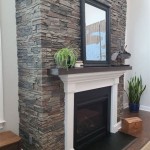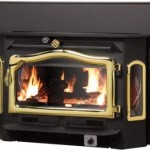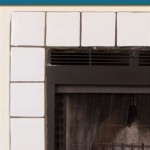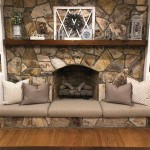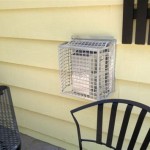Tiled Fireplace Hearth: A Comprehensive Guide
A fireplace hearth, the non-combustible flooring area extending from the fireplace opening, serves a crucial role in fire safety and aesthetic design. Tiled fireplace hearths, in particular, offer a versatile and durable solution for homeowners seeking both functionality and visual appeal. This article provides a comprehensive overview of tiled fireplace hearths, covering their benefits, material considerations, installation process, and maintenance requirements.
Benefits of a Tiled Fireplace Hearth
Tiled hearths provide numerous advantages over other materials, making them a popular choice for fireplace surrounds. One of the most significant benefits is their inherent fire resistance. Properly selected and installed tile forms a non-combustible barrier that protects the surrounding flooring and structure from sparks and embers. This greatly reduces the risk of fire damage and enhances overall home safety.
Durability is another key advantage. Tile, especially when made from materials like porcelain or stone, is exceptionally resistant to scratches, dents, and staining. This makes it a practical choice for a high-traffic area that is frequently subjected to heat and ash. Unlike materials like wood or carpet, tile can withstand years of use without showing significant wear and tear.
The aesthetic versatility of tile is also highly desirable. Tile is available in a vast array of colors, patterns, sizes, and textures, allowing homeowners to customize their hearth to match their existing decor or create a unique focal point. Whether the desired aesthetic is modern, rustic, traditional, or contemporary, there is a tile option to suit almost any design preference.
Maintenance is relatively simple with tiled hearths. Most spills and stains can be easily cleaned with a damp cloth or mild detergent. The non-porous surface of many tile types prevents absorption of liquids, further simplifying the cleaning process. This low-maintenance aspect makes tile a practical choice for busy homeowners.
Finally, a tiled hearth can increase the value of a home. A well-designed and properly installed tiled hearth adds visual appeal and enhances the overall perceived quality of the fireplace. This improvement can be a significant selling point when the time comes to put the house on the market.
Material Considerations for Tiled Hearth Construction
Selecting the appropriate tile material is crucial for ensuring the longevity, safety, and aesthetic appeal of the fireplace hearth. Several factors should be considered, including heat resistance, durability, porosity, and design preferences.
Porcelain tile is a popular choice due to its exceptional durability and heat resistance. It is manufactured at high temperatures, resulting in a dense, non-porous material that can withstand the extreme heat generated by a fireplace. Porcelain tile is also resistant to staining and scratching, making it a low-maintenance option. The wide range of colors and styles available in porcelain tile makes it a versatile choice for any decor.
Ceramic tile is another common option, though it is generally less durable and heat resistant than porcelain. Ceramic tile is more porous than porcelain, which means it is more susceptible to staining and moisture absorption. However, it is typically less expensive than porcelain, making it a budget-friendly option for some homeowners. It's important to ensure the ceramic tile selected is rated for high-temperature applications.
Stone tile, such as slate, granite, and marble, offers a natural and elegant look. Stone tile is generally durable and heat-resistant, but its porosity can vary depending on the type of stone. Sealing the stone tile can help protect it from staining and moisture absorption. The unique patterns and textures of stone tile can add a touch of sophistication to any fireplace.
Firebrick is a specialized type of clay brick that is designed to withstand extremely high temperatures. It is often used to line the firebox of a fireplace, but it can also be used for the hearth. Firebrick is exceptionally durable and heat-resistant, making it an ideal choice for high-heat applications. However, its appearance is generally more rustic and less polished than other tile options.
In addition to the tile itself, the mortar and grout used to install the tile must also be heat-resistant. Specialized high-temperature mortar and grout are available to ensure the integrity of the hearth construction.
Installation Process and Key Considerations
Proper installation is critical to the functionality and safety of a tiled fireplace hearth. This process requires careful planning, preparation, and execution to ensure a durable and aesthetically pleasing result. Incorrect installation can lead to cracking, crumbling, and potentially dangerous fire hazards.
The first step is to prepare the substrate. The substrate is the underlying surface upon which the tile will be installed. It must be clean, level, and structurally sound. If the existing hearth is made of wood or other combustible material, it must be removed and replaced with a non-combustible substrate such as concrete or cement board. This is essential for fire safety.
Next, a layer of cement backer board is typically installed over the substrate. Cement backer board provides a stable and moisture-resistant surface for the tile. It is attached to the substrate using screws and thin-set mortar. The seams between the boards should be taped and mudded to create a smooth and seamless surface.
The tile layout should be carefully planned before installation begins. This involves determining the placement of the tiles, taking into account the size and shape of the hearth, and ensuring that the tile pattern is symmetrical and aesthetically pleasing. Dry-laying the tile before applying mortar helps to visualize the final result and make necessary adjustments.
Thin-set mortar is then applied to the backer board using a notched trowel. The tile is carefully placed onto the mortar, ensuring that it is level and properly aligned. Tile spacers are used to maintain consistent grout lines between the tiles. Excess mortar should be wiped away immediately.
After the mortar has dried, the grout is applied to the joints between the tiles. The grout is pressed into the joints using a grout float, and excess grout is wiped away with a damp sponge. The grout should be sealed to protect it from staining and moisture absorption. A specialized heat-resistant grout sealant is recommended.
Expansion joints should be incorporated into the hearth design to accommodate thermal expansion and contraction. These joints are typically filled with a flexible sealant to prevent cracking and movement. Consult with a professional installer for guidance on the placement and size of expansion joints.
Finally, it is crucial to adhere to local building codes and regulations when installing a fireplace hearth. These codes often specify minimum clearances from combustible materials and require the use of approved materials and installation methods. Obtaining the necessary permits and inspections can help ensure that the hearth is installed safely and correctly.
Maintenance and Care for a Tiled Hearth
Proper maintenance is essential for preserving the beauty and integrity of a tiled fireplace hearth. Regular cleaning and occasional repairs can help extend the life of the hearth and prevent costly damage. Neglecting maintenance can lead to staining, cracking, and other problems that can compromise the hearth's functionality and appearance.
Regular cleaning is the most important aspect of hearth maintenance. The hearth should be swept or vacuumed regularly to remove ash, dust, and other debris. Spills and stains should be cleaned up immediately to prevent them from setting into the tile or grout. A damp cloth or sponge and mild detergent are typically sufficient for cleaning most spills. Avoid using abrasive cleaners or scouring pads, as they can scratch the tile surface.
Grout is particularly susceptible to staining and discoloration. Grout sealants should be applied periodically to protect the grout from moisture absorption and staining. If the grout becomes stained, specialized grout cleaners can be used to remove the stains. A toothbrush or grout brush can be used to scrub the grout lines.
Inspect the hearth regularly for cracks, chips, or loose tiles. Small cracks can often be repaired with epoxy or grout filler. Loose tiles should be reattached using thin-set mortar. Larger cracks or significant damage may require professional repair.
Chimney maintenance is also important for the overall health of the fireplace and hearth. A clean chimney reduces the risk of chimney fires and ensures proper ventilation. Have the chimney inspected and cleaned annually by a qualified chimney sweep.
Avoid placing heavy objects directly on the tiled hearth, as this can cause cracking or damage. Use a protective mat or rug under heavy objects to distribute the weight more evenly. Avoid using excessive heat or harsh chemicals near the hearth, as this can damage the tile or grout.
:strip_icc()/101343186-8909e34a95d74e0087ce39e27577ca41.jpg?strip=all)
How To Tile A Fireplace Hearth

How To Tile Over A Brick Hearth Shine Your Light

How To Tile A Fireplace Surround And Hearth Build Basic

How To Tile A Fireplace My Uncommon Slice Of Suburbia

Operation Hearth Re Tile Grouted Goodness Fireplace Tiles Home Remodel

Fireplace Tiles Classique Floors Tile Portland Or

Fireplaces Renditions Tiles

How To Remove Quarry Tile Level New Tiles

Redondo Beach Tiled Fireplace And Hearth Tile Installation Stone Fabrication

Plain Square Glazed Tiled Fireplace Hearths Twentieth Century Fireplaces


